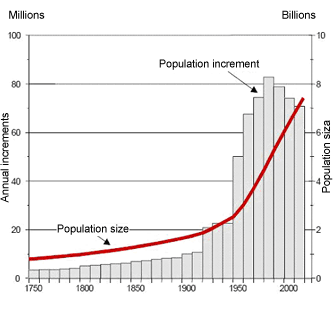Recently I saw a startling graph, plotting world population from the Middle Ages to projections for 2050. The red line remains relatively flat for several centuries, starts ramping up around the time of the 19th century Industrial Revolution, and then takes off like a Roman candle right about the time of my own birth, in the mid-1950s. Granted, the steep rise was enhanced by the drawn-out time scale of that particular graph. As you shorten the time frame you’re looking at, the slope flattens out. But the numbers paint a sobering picture on their own.

I decided to plot some of my own family history against that curve. When my father entered the world on the eve of the Great Depression, there were barely two billion people populating the globe. By the time I came along, the number had nudged above three billion. This was America’s legendary Baby Boom and the beginning of the Roman candle phase (an exponential growth trajectory which continues today). Should I be so fortunate (or unfortunate) to make it to my own century mark, demographers project that by then (2055), the Earth will be asked to support more than nine billion people. That’s a tripling of the world’s population just in my (theoretical) lifetime.
Population growth seldom takes center stage in discussions of climate change, though the connection is undeniable (heck, nine billion people just breathing is a lot of CO2).
 Biologist William Ryerson, President of the Washington-based Population Institute, says that population growth is “not an inconsequential impact on the climate crisis.” But breathing is not the problem; it’s consumption. Appearing on KQED’s Forum program with Michael Krasny, Ryerson said that were that prediction of nine billion people by 2050 to be realized, it would be “the climate equivalent of adding two United States to the planet.”
Biologist William Ryerson, President of the Washington-based Population Institute, says that population growth is “not an inconsequential impact on the climate crisis.” But breathing is not the problem; it’s consumption. Appearing on KQED’s Forum program with Michael Krasny, Ryerson said that were that prediction of nine billion people by 2050 to be realized, it would be “the climate equivalent of adding two United States to the planet.”
Ryerson, who also heads the Population Media Center in Vermont, says we’ll be lucky to make it to nine billion. Ryerson said that in his view, “the resources just aren’t there,” for a doubling of the current population. He cites research by Stanford biologist Peter Vitousek, indicating that humans are already appropriating half of the total global “products of photosynthesis, i.e. all green plants.”
It seems that after decades of being dismissed by mainstream economists, 18th-century philosopher Thomas Malthus is getting a fresh hearing. Malthus made his reputation as a doomsayer in 1798, when he wrote that “the power of population is indefinitely greater than the power in the earth to produce subsistence for man.”
As procreation and climate change accelerate in tandem, the two forces may place a double bind on basic resources like water (see also Gretchen Weber’s post on “peak water“). Ryerson, who recently visited Pakistan, says that nation currently has 20% of the water that they had 50 years ago, on a per-capita basis, and “they’re on a 30-year doubling time,” meaning 368 million people by 2040.
The entire Forum program is available online.
2 thoughts on “Population: The “Other” Climate Debate”
Comments are closed.

yes, this is the unspoken tragedy of the planet — I lived in India 2 years and made my commitment to zero population growth and had only one child as my personal planetstewardship. I have also supported Planned Parenthood, etc. and am horrified at the worldwide “educated male” Roman Catholic religion that continues to preach “have children.” And, there is war supported by “educated male” leaders with the consequences of rape and pillage. Perhaps we need “educated women” to solve this problem, including the daughters of Allah. How about licences to have a child, so much more precious and needing responsible care than a car, another “male symbol.” There is a lot of waking up to do.
What a joke… this is not “debate”… just regurgitation of the infamous Mann “hockey stick” better described as hokey.
So far Gore refuses to debate Sussman nor any other who have a grasp of the facts on Climate Fraud.